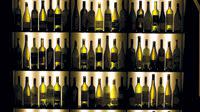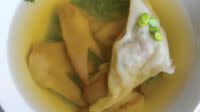Undiscovered Hungarian Wine

In this article:
"They say two million people dwell in Budapest, but only 2,000 live," Attila Tálos tells me, pouring a glass of Hungarian rosé. There's little doubt which category he belongs to. We're lounging in Klassz, the wine bistro Tálos owns, along with nearly a dozen stores, all devoted to Hungarian wine. Bright pop art patterns paper the walls. Outside, a freak sun-shower is turning Budapest into something from the French New Wave. A young woman in a sodden sundress skips past, covering her hair with a newspaper; on cue, a rainbow sprouts across the boulevard. I briefly consider abandoning my mission, which is to visit Hungary's main wine regions and try to make some sense of them. After all, there's enough wine here, right in this room.

© Lily Idov
In Hungary, there's wine everywhere—the funky Furmints of the Tokaj region; the Pinot Noir–like Egri Bikavérs of Eger; complex blends from Villány, Balaton and Szekszárd; and hundreds of thousands of unnamed, unlabeled variations in between. Hungary has always been a country of winemakers. "In almost every family, someone—your father, your uncle—had a small vineyard," Tálos says. "That's how you grew up." But now, more than ever, wine—growing it, making it, drinking it, talking about it—is Hungary's singular animating passion. Walking into a Budapest bookstore, I'm not particularly surprised to see a wine section—not books about wine, but actual wine bottles. It's a fervor that started in Hungary in the early 1990s, a time when it seemed like anything could happen and everything was a start-up. Family businesses began emerging from the underground. The nameless bottles of the Communist era began acquiring labels—and, along with the higher quality, higher prices.
Now, the Hungarian wine scene is at the forefront of a broader movement all over Eastern Europe. Over the last two decades in Slovenia, Croatia and even troubled Romania, domestic winemaking has gone from rustic tradition to viable and, in some cases, big business. And what that means for all these countries is the next step: presenting their wines to a world spoiled by wave after wave of high-quality bottlings created everywhere from France to Uruguay. Exactly who or what—a producer, a grape, a blend, a country—will become the former Eastern Bloc's first breakout star is the question everyone here is asking.
But the past is hard to shed. Before 1990, Hungarian wine could only be made noncommercially, for friends and family or the communal vat of a state cooperative. The system wasn't about quality or finesse; it was about maximizing exports to the nearby Soviet Union, the world's most enthusiastic consumer of swill. Years of academic research went into producing new grape varieties like Zenit, designed for maximum yield. (It is now a point of ironic pride for Hungarian winemakers to use a bit of Zenit in their blends, like driving a souped-up Trabant is for Germans.) Yet somewhere among those backyard vines, in tiny batches, traditions were kept alive.

© Lily Idov
István Szepsy, without a doubt the most respected winemaker in Hungary, lives two-and-a-half hours or so northeast of Budapest, in the remote, hilly Tokaj village of Mád. Szepsy is the sage to whom all other winemakers here defer, and any visit to his winery takes on an instant air of pilgrimage. So it's fitting that the last miles of my trip are mostly spent driving upward.
When it comes to the history of Hungarian wine, Szepsy prefers the long view—40 million years long, to be precise. A sly, robust 60-year-old in rolled-up shirtsleeves, he meets me holding up a reddish chunk of zeolite. He keeps it handy just for this type of occasion. "All of Hungary was covered with water then," he explains. "And there was an active volcano under the water. Later, the water came up through the cracks as steam and created these materials." He picks up what looks like a sculpture of an animal jaw. "See, this deer fell into hot water and was fossilized." The show-and-tell is Szepsy's idea of the best way to explain the stony soil in which his grapes grow. His family has been making wine for several hundred years, but he claims to have truly understood the terroir only in the last 12 or so.

© Lily Idov
Szepsy's Szent Tamás vineyard perches atop a hill overlooking Mád, visible as a mosaic of tiled roofs. Vines old and new cover the slopes, some tied to individual stakes in the ancient manner. The variety he grows here is Furmint, which is the main grape of the Tokaj region, its claim to fame and, to an extent, its curse. Furmint often matures until it bursts, but unlike most other grapes, it grows a second skin over the split, which allows it to concentrate amazing amounts of sugar. Thanks to this freak of genetics and the similarly sugar-concentrating "noble rot" common in the region, Tokaj has become a one-hit-wonder. The region is known worldwide for a single thing: golden, unctuous, old-fashioned dessert wine, Tokaji Aszú.
Tokaji was the drink of choice for everyone from Louis XIV to Beethoven to Peter the Great to Hitler. The region itself is name-checked in the Hungarian national anthem. But in Tokaj, a race is under way to leave the sticky heritage behind. "The question is, is it possible to produce a very serious dry wine here or not?" says Szepsy. "What we are aiming to achieve now is dry wine that's complex, with long aging potential, full of minerals to express this soil." In his dank, narrow cellar, Szepsy pulls the cork from a slender bottle of his 2007 Szent Tamás Furmint, born on the hilltop lot we just visited. The only dry Furmint I had tried before this, in an unassuming pub in town, was awful. It tasted like dry sherry diluted with water. But Szepsy's is spectacular: bone-dry, subtly oaky, with a whiff of lavender and the bitter bite of mountain herbs. Next, we try the 2009 Furmint from his favorite vineyard, Úrágya, which literally means "the bed of God." It's fresher, crisper, more Riesling-like. We move on to the region's second-most-important grape, Hárslevelu, and Szepsy's favorite vintage, 2008. I'm thinking, This is Tokaji?
"If Americans got used to dry Riesling, they can definitely get used to this," I blurt out. Szepsy smiles politely. He's not making this for Americans.
Hungary is a stubborn place. Neighbors see it as idiosyncratic and surly, forever pining for an imperial paradise lost. Hungarians have names the rest of the world associates with bad things, like Attila and Nimrod, and converse in an ancient tongue, with no Slavic or Latin roots, that no one else can understand. The 20th century landed the country on the wrong side of two world wars, then followed that up with 40 years of Soviet rule. Yet Hungarian pride—particularly pride of place—didn't miss a step. It is something to witness. Winemakers strive to procure barrels made from the oak not only of their country but of their county. Suggest that a wine is local when it's made 40 miles away, and your waiter will probably take offense (at least mine did). And don't expect pubs in the town of Tokaj to pour anything from Eger. Eger, a sleepy town about 75 miles south, couldn't care less about Tokaj, either. That's because Eger is the home of Egri Bikavér—or, as the rest of the world knows it, Bull's Blood.
In the Soviet Union of my youth, Bull's Blood was a bit of a joke: a syrupy, bottom-shelf mix of three or four varieties led by Kadarka, Hungary's unpredictable native grape. "Even we don't know what it actually is," Tálos had laughed, back in Budapest. "Sometimes it's dark, sometimes it's black, sometimes it's tannic, sometimes it just smells like Coca-Cola." Egri Bikavér's original purpose, per local legend, was to fortify soldiers before battle; its latter-day function was to get the buyer blind-drunk on a budget. Lately, its reputation has changed for the better, largely thanks to György Lorintz of the St. Andrea winery.
After a perilous truck ride through bristly thickets, I am standing on hallowed ground on the side of Nagy Eger mountain, home of the best Egri Bikavérs. A large statue of the Virgin Mary looms over the St. Andrea vineyards. Lorintz is serious about God. "In a way, I think God wanted me to go into the wine business," he tells me. Lorintz is quiet and dour, speaking in a doleful monotone that belies his jock past: He was once on the national water polo team (the sport is Hungary's baseball). He chose Budapest as his college town because it had the best pools, and winemaking history as his college major, just to have one. Being an athlete, he didn't even drink at the time.

© Lily Idov
Rather than Kadarka, Lorintz uses Kékfrankos (the Hungarian name for Blaufränkisch) as the main grape in his Egri Bikavérs. Back at the winery, we taste several of his wines before getting to his 2006 St. Andrea Merengo, "the best wine I ever produced," he declares. It's a blend of Kékfrankos, Merlot, Cabernet Franc and several other grapes, and it's a masterpiece. Muscular, tannic, laced with coffee and leather, it is, for lack of a better comparison, like an inverted stone pyramid: hard and heavy in such a way that if even one of its components got out of perfect balance, the whole thing would flatten you. It's the best wine I try on the trip, and probably—as I write this, a few months later—this year.
How does one take a wine from a country associated with things either cheap or sugary, a country that up until 20 years ago did not even know what the global market was, and make it into an international hit? Will a Westerner plunk down $50 for something from Eastern Europe that isn't a Lenin bust or a fur hat.
To succeed internationally, Hungarian wine—like the wines of all the former Iron Curtain countries—can do one of two things: Be itself, with all its local idiosyncrasies, and hope for wine lovers to flip over its novelty; or try to do what everyone else does by growing and bottling perfectly good (and more easily sellable) Pinot Noirs and Chardonnays. Szepsy and Lorintz both lean toward the former. So does Attila Gere, one of Hungary's biggest wine producers, who uses the same mix of local traditionalism and global ambition in his tremendous Kopár reds. And so do most of the truly interesting winemakers in countries like Romania and Croatia.
Back at Klassz in Budapest, Attila Tálos uncorks a bottle of Balaton Sauvignon Blanc with a woodcut picture of a tractor on the label. Socialist nostalgia? No. "This wine is called Béla és Bandi," Tálos explains, "because it's made by these two guys named Béla and Bandi." In Hungarian context, that's like naming your wine "Josh and Pete"—not a drop of wine-country romanticism there.
"See, it's a dead end, trying to define Hungary," Tálos says. "What is Villány about? What is Egri Bikavér? If I were in charge of marketing Hungarian wine, I wouldn't even bother. We're a country with half a million winemakers! The amazing part is the variety. Just let it live, and something will shake out of it.
"When Béla és Bandi first started selling this wine, they asked me for advice," Tálos says, pouring two glasses. "They originally wanted to put a picture of a château on the label. I told them, No! Embrace the fact that you're two Hungarian guys with a tractor!"
I nod in agreement and stick my nose into my glass, then take a sip. Whoever Béla és Bandi are—and it's a relief, for me and for them, not having to know this—their wine is delicious. *
Michael Idov is a contributing editor at New York magazine and the author of Ground Up, a novel loosely based on his experiences running a coffee bar in NYC.
Hungarian Wine: Budapest's Best Wine Spots
Budapest has an extraordinary range of places to try great Hungarian wines, from white-tablecloth restaurants to scruffy hipster bars.

© Lily Idov
Borkonyha/Winekitchen
Every bottle from this low-key bar's substantial list of Hungarian wines is right here, inside a gigantic cooler lining the front wall.
Csalogány 26 (left)
Lightened-up Hungarian classics and fearless pairings (sweet Tokaji with prawns and gnocchi, for example) are the hallmark of this wine destination.
Onyx
Onyx received a Michelin star in March 2011, only the second restaurant in Hungary to achieve that honor. Executive chef Szabina Szulló's avant-garde versions of classic Hungarian dishes can be paired with more than 200 wines.
Klassz
Attila Tálos, the owner of Hungary's Bortársaság ("Wine Society") chain, sets aside some rare bottles for this funky wine shop–bistro.
Szimpla Kert
The quality of the wine can be a variable, but no Budapest visit is complete without a tour of its "ruin pubs." Szimpla Kert is among the best.
Hungarian Wine: Top Eastern-European Wines
Hungary
2006 St. Andrea Egri Bikavér ($25) Grown on Hungary's Nagy Eger mountain, this powerful, dry red blend from György Lorintz redeems the notoriously awful wine called Bull's Blood.
Hungary
2005 Szepsy Tokaji Aszú 6 Puttonyos ($150) Sweet, honeyed Tokaji Aszú is Hungary's most famous wine, and this bottling is like a master class in what great Tokaji should taste like.
Croatia
2007 Enjingi Grasevina ($17) Winemaker Ivan Koloman takes Grasevina, inland Croatia's humble go-to grape, and elevates it to world-class quality in this seductive white.
Slovenia
2009 Sanctum Chardonnay ($17) Made in a tiny winery near the tiny Slovenian town of Ptuj, this elegant, unoaked Chardonnay could be mistaken for a premier cru Burgundy.
Romania
2009 Cramele Recas Dreambird Pinot Grigio ($9) One of the few Romanian wines that's relatively available in the US, this light-bodied, peachy white is simple but appealing.
European Wine Guides:



